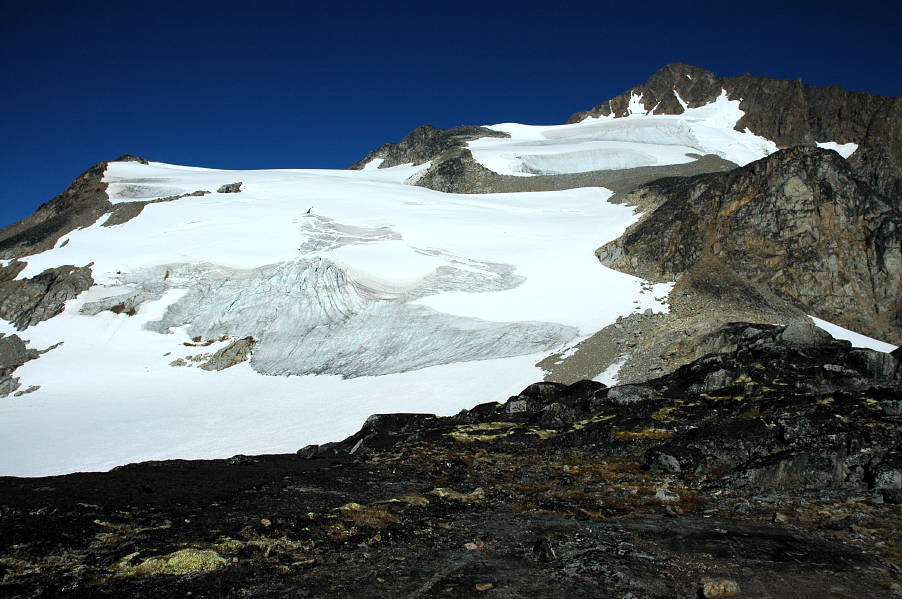The East Ridge of the Doormouse
August 13 , 2007
It was the warmth of the sun that finally woke me. It was 10 am, my watch said. Bob had been up and moving about for some time and was outside of the tent. Mike flittered about. I finally got out of my bag and stepped into the pleasant air outside. The tent stunk. Today we would rest and I could reflect upon yesterday's hairiness. Yesterday's fear. Yesterday. But first tea, that wretched Pu-Erh that I was coming to like, not for its flavor but for the caffeine in it, caffeine that would lift my mood and make things seem alright. Two liters of tea brewed, we adjourned to the tent to play cards. Playing cards with Mike is no easy task, for he generally takes the game at hand seriously. He thinks strategically, and it is a rare occasion that I can actually win a hand.
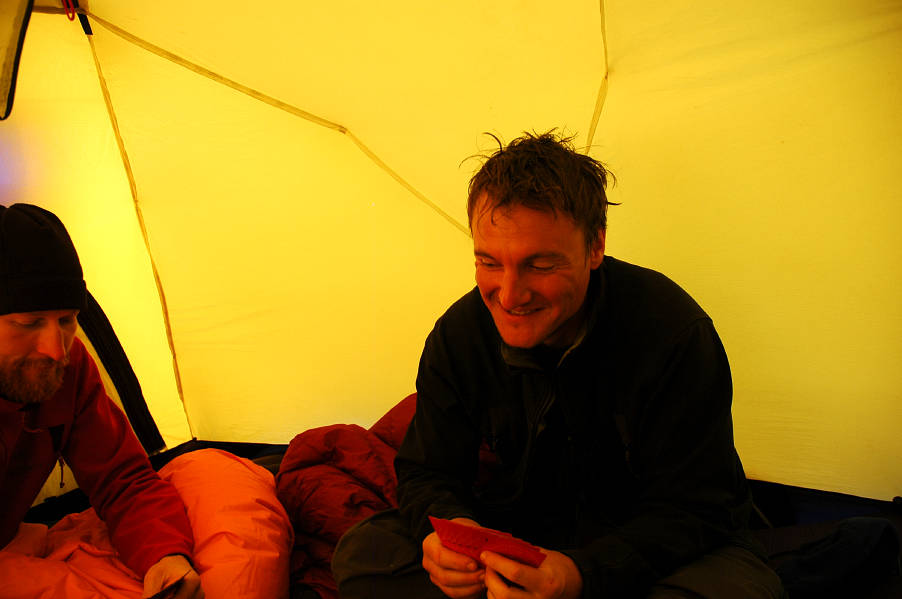
The rest was much appreciated and I spent the afternoon engaged in chores that seemed pleasant and reassuring, instead of being, well, chores. Like washing out my socks in a pool of water. Rather than trying to get the chore over with quickly, I spent time in locating a nice pool. I spent time located an edge of the pool on which to scrub the socks. I spent time carefully scrubbing and rinsing one sock. Scrub and rinse again. I focused only on scrubbing and rinsing, on the task before me, instead of brooding over yesterday. Mike worked at finding a slow leak in his sleeping mat. Mike and Bob finished cutting the rope that the rock yesterday had damaged. We now had three ropes, of lengths 60, 40, and 20 meters. The sleeping bags were set out in the sun to dry and freshen. If all this sounds boring, I can quite assure that it was not.

The day lengthened and I found a choice spot in the sun to lounge and read and write. The three of us would talk at times when the mood struck us. We would be quite that seemed the better option. Today was a zero day, a luxury that can not be known in the settled world. It isn't that we did nothing. Rather the joy was in not doing something. Tomorrow we would go back to work again. On the other side of the col from us, opposite the west ridge of White Rabbit, was a peak that looked quite doable, and quite unclimbed. Steep snow and ice would get us a long way, with what looked like a pleasant, low angle rock ridge to the summit. A pesky notch near the end could, hopefully, be bypassed. With the clear skies would could see the full extent of the west ridge of White Rabbit. The two hour time estimate wasn't a good one. We had topped out on the last gendarme. However, a very vertical, long section of rock, a face on the ridge, would have required a rope to come out. Clearing the face would have taken nearly two hours, for it was long and may have been several pitches in length. From there, a lower angled ridge led to the summit. We were three or more hours away, and the descent would have required building at least one, probably two or three, anchors to rappel from. We would not have gotten back to camp until midnight. We had made the right decision.
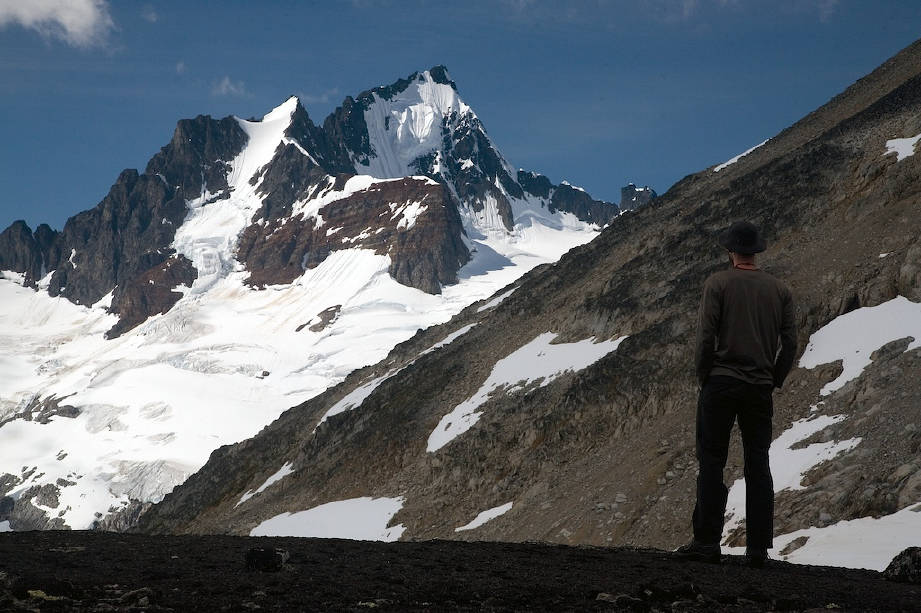
My experience on White Rabbit had not been a pleasant one. I was after experiences, not summits, and this distinction was brought out to the fore yesterday. Summiting, for me, was quite optional and was ranked far below having fun and enjoying the whole time out there. I hoped for a better experience tomorrow, as well as a summit. The afternoon drew into the evening and we had our normal meal of soup, something dried several months ago, and chocolate. Mike's wrist was getting worse and the pain was keeping him from using his right hand. Ibuprofen wasn't helping much and the fact that the injury had not improved over the five days since its occurrence was a source of worry for all of us. The climb up the snow to the rock ridge would require the use of an ice axe, particularly in the event of a fall. If Mike took a fall on the steeper section, it was unclear that he would actually be able to stop himself. Fortunately, the run out of the slope was fairly good and the most likely outcome would be a long re-climb. But if his wrist did not improve, it would not be a good idea to try Ambition or Endeavour. That might be a good thing. Where as our goal for tomorrow looked manageable, those two peaks looked terrifying. For now, I held tightly to cautious optimism. Ambition and Endeavour would be dealt with in time. They did not matter for tomorrow. They did not exist, indeed. I slept well, hoping for good weather in the morning.
"We go!" That damn cheery voice again. Five am on a col just above a glacier is no time to be cheery. I put my boots and hat on and stumbled out of the tent to light the stove. I was beginning to really need the Pu-Erh tea. The sky overhead was clear, but there were ominous clouds out to the east, exactly where the weather systems had been coming from. I dined on an exceptionally tasty square of Hudson's Bay Bread, the same breakfast that I'd had for the last five days. The same breakfast that I'll have for the next two weeks also. The hot tea warmed me and the caffeine cheered me and in no time I was ready to climb. At 6 am we set off down the rock, heading in the direction away from White Rabbit. We scrambled the rock for a while, heading up the other side of the col, until it became clear that the snow was the better option. On crampons.

We climbed the snow with ease, inclined at a moderate 20 degrees, with Bob leading the way kicking steps. Mike and I offered to lead and spell Bob, but he liked being up front and so Mike and I stayed in the rear and relaxed. The snow was broken by stretches of rock long enough for us to remove crampons, only to put them back on a few hundred yards later. White Rabbit, and its west ridge, dominated the our view.
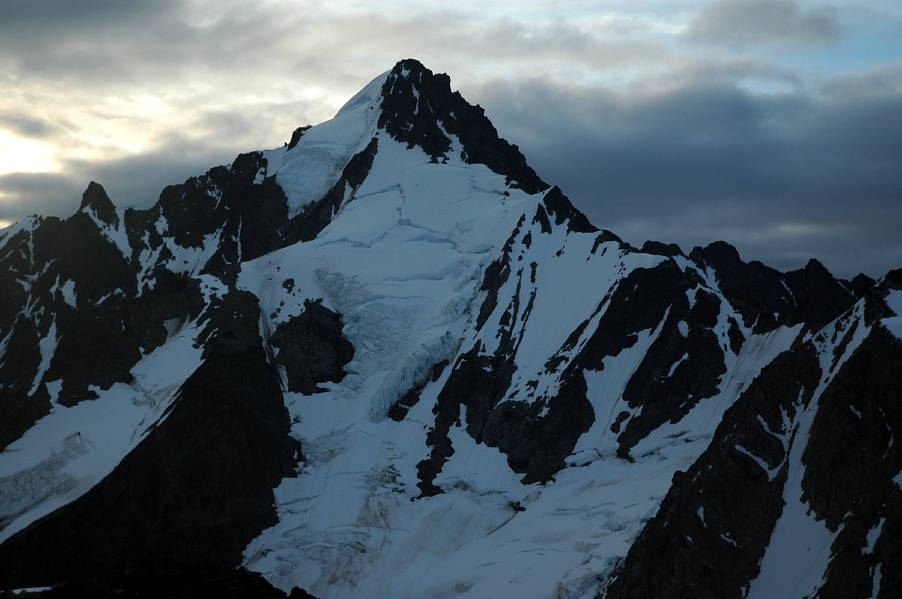
The grade of the snow began to stiffen and the progress began to slow. From a gentle 20 degrees it slowly ramped up to 25. Then to 30. Bob had led almost the whole way and was paying a price for it. Though he was fine cardiovascularly, his calves were burning from the effort of kicking steps and, now, front pointing. Mike and I spread out and went up front, each taking our own route according to our own preferences.
[Note: In the below photo showing Bob coming up the snow, you can almost see our yellow tent down in the rocky col in between us and White Rabbit, the mountain in the background. The west ridge is the right, rocky skyline. We made it to just below the last bump on it.]
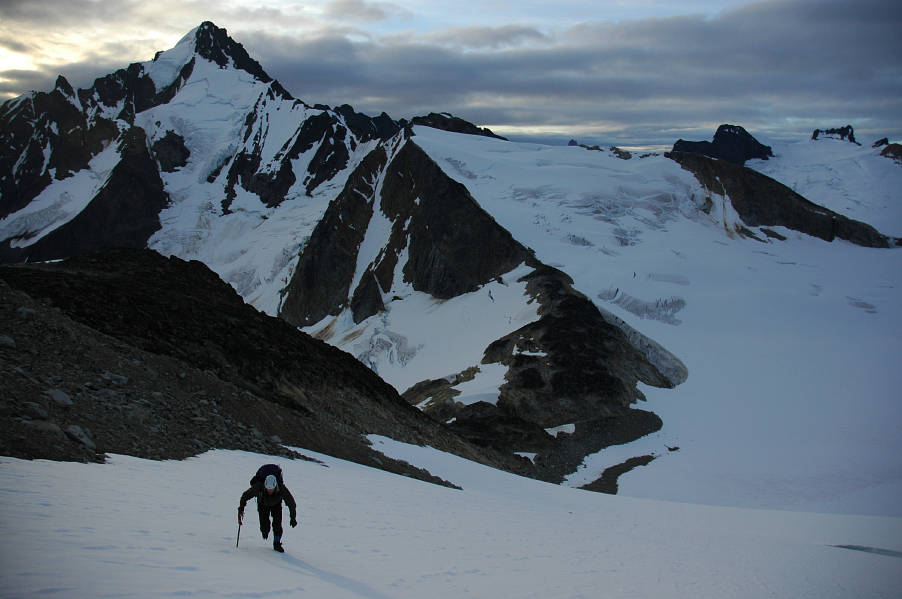
The snow steeped to 35 and then to 40 degrees. Although I was able to avoid front pointing, and thus save my calves, when the snow got to 45 degrees and then turned to ice, I had no other options. A few hundred vertical feet of front pointing led to lower angle snow and eventually a broad plateau.
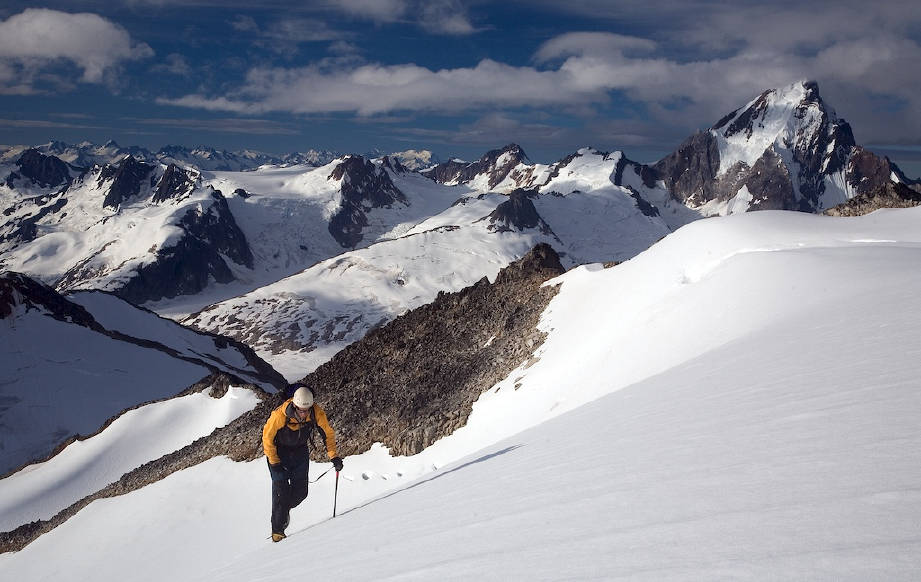
Bob had slowed to a crawl coming up the steeper ice. Without a place to rest, he couldn't take the pressure off of his calves, blown out from the earlier climbing. I grabbed a picket from Mike and used the one I was carrying to build a quick anchor snow anchor and tossed down a rope for Bob to use as a hand line just in case. Slowly he made his way up, occasionally using the hand line, and joined us on top of the plateau, which we had taken to calling a whaleback.
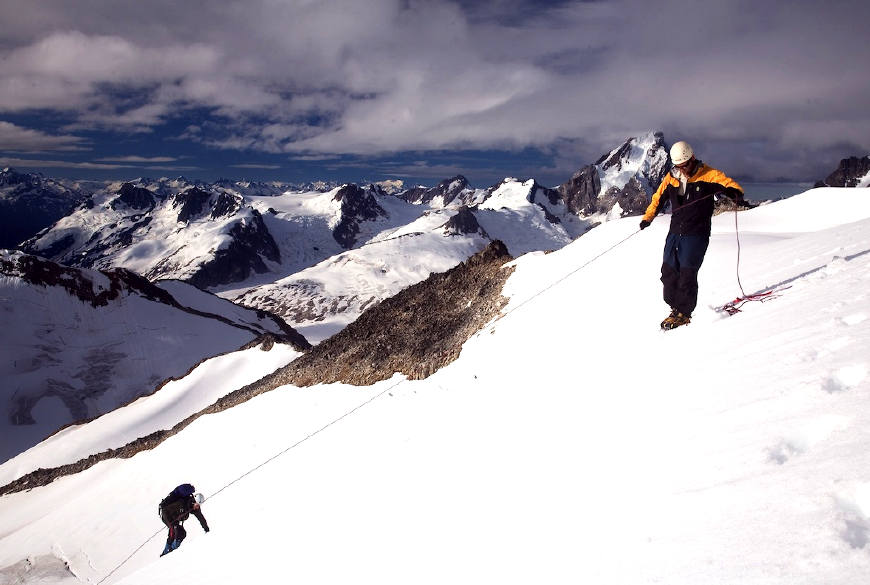
The glacier had gained us much elevation and we seemed almost able to touch the top of the peak. We sat in the snow and checked a GPS reading, which told us we still have more than a thousand feet of elevation to gain. But, it looked pretty easy from here. Surely that pesky little notch on the ridge could be circumvented. It just looked too sweet to be a problem. We rested on the whaleback for a while before trekking across it to the base of the rock wall that would lead us to the ridgeline. Ambition and Endeavour looked as scary as they did from lower down.

We took another long rest at the base of the rock, for it wasn't even 10 o'clock yet and the weather looked good. Clouds raced by, but they were big puffies and not the sort of clouds you associate with a coming storm. We spent forty minutes sitting on the rock resting and eating before we set off once again, leaving our snow and ice gear behind. The rock on this side of the col was far superior to the awful stuff on White Rabbit, something that made me quite happy. We worked our way up the rock, climbing short face sections and clamoring through mini gullies. Unfortunately for me, the rock, though quite sound, had some looseness to it. In the midst of a gully climb, Mike, above me, dislodged a head-sized chunk of rock that tumbled 15 feet down before popping me in the arm and head. I was well situated on a foot wide ledge at the time and suffered only a sore arm. No bleeding, but I could feel my wrist begin to stiffen. Although it wasn't serious, it did remind me of two days before when I almost killed Bob by rockfall. I was becoming paranoid about knocking rocks down on Mike and Bob and getting hit myself only reinforced this.
We exited the gully and found a vertical, though blocky, face about 50 feet high. Bob and I began to climb on the left side while Mike chose the right side. The climbing began as the standard 4th class work that we had come to expect, but stiffened after a few moves into low fifth class. A bit higher and Bob and I were looking at something mid-5th class. Given the rock quality and the remoteness, it was time for a rope. Mike was over on something that looked a lot harder than what Bob and I were facing. Mike's arm was hurt. But, rather than backing down, Mike calmly moved up and across the rock, enjoying himself on a little jaunt: The climbing was well within his comfort zone and he was taking special care to test holds as he went. We saw Mike scramble over the top and disappear. A few minutes later, a rope was tossed down to us. Bob tied in and climbed up, disappearing over the top after a minute or two. The rope came back down to me and off I went, climbing quickly up to the top. Bob and agreed that our pitch was about 5.6 according to current standards.
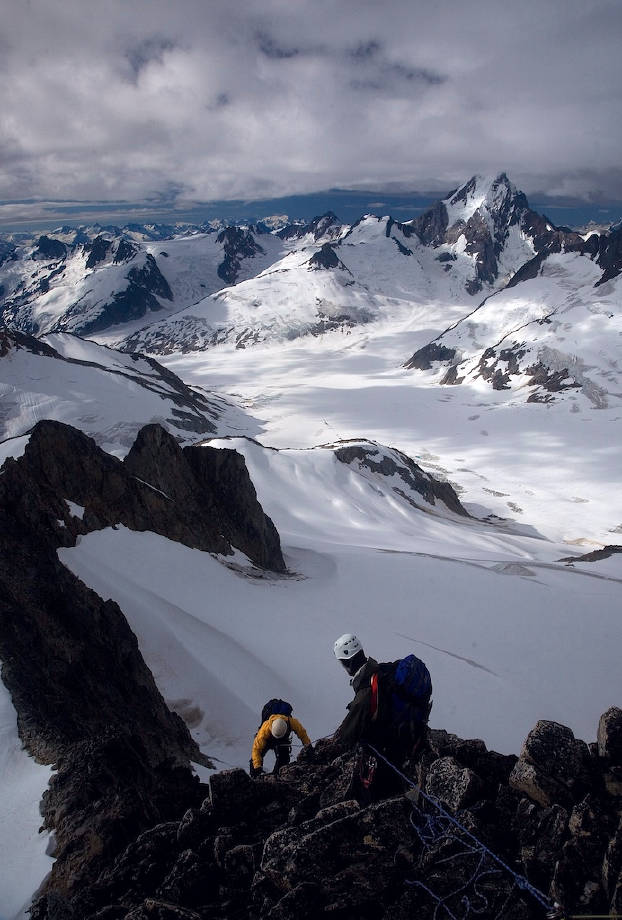
We broke down Mike's anchor and set off for the top, which seemed close and easy. The scrambling was on a broad ridge with no exposure, and large, solid rocks. The weather was getting better and success seemed assured. No one bothered to bring up that notch that we had seen from down below. We gained elevation, joking and chatting as we scrambled, until we came to something like a knifedge, a short, narrow piece of the ridge where the world fell off for a few hundred feet on either side. Spectacular, fun work. Unfortunately, on the other side of this feature we quickly came to the notch. The steepness of the mountain was quite apparent here, as the base of the notch, perhaps 25 feet below us, was the only place we could land. A few feet on either side and the world dropped away. To get down into the notch we built and anchor and set the 20 meter rope as a rappel line. I was petrified as I descended, as Mike and Bob were below me and there wasn't enough room at the notch to dodge any rocks that I might send down. But I got down without killing either of them, which made me, and them, rather happy.
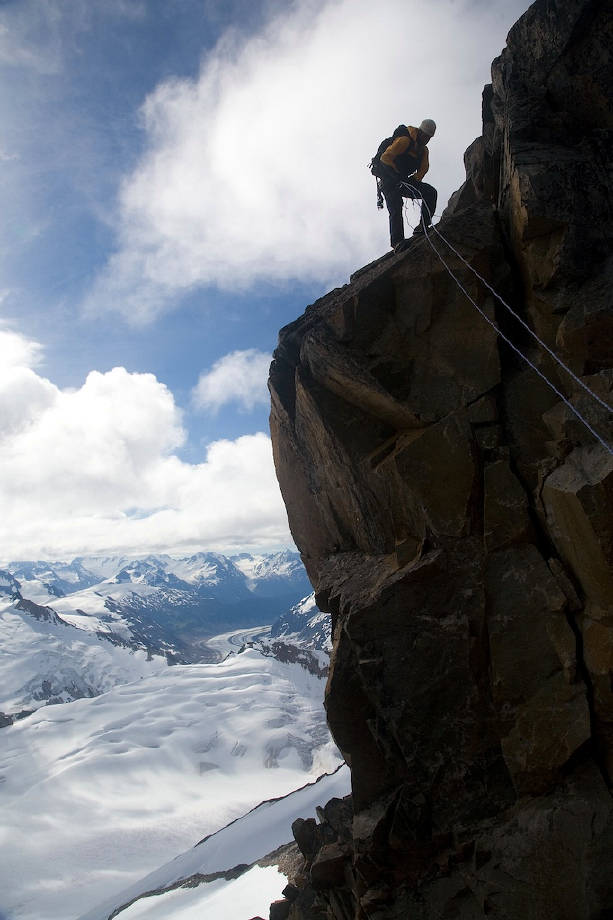
Note: In the below photo you can see Bob giving me a firemen's belay as I rappel. The prominent peak in the background is Dokdaon, which you'll meet in a few days time. We'll eventually move our camp to a spot near its base. In fact, you can probably just about see where we camped, below and to the left (in the photo) of the bare ice at the base of Dokdaon. Endeavour is the the peak in the clouds to the left of Dokdaon, and the Nipple is between the two.
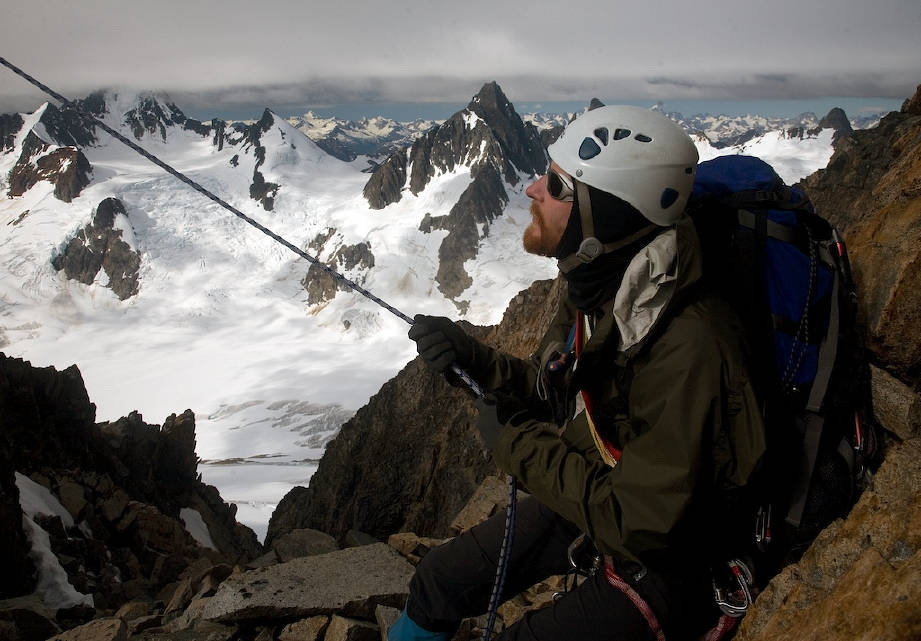
The was large enough for the three of us to stand around and gawk, but it would have been a little cramped for a picnic. We left the 20 meter rope on the anchor so that we could top rope up on our way down. Although Mike was certainly happy to have some one else lead, this was expedition climbing and the strongest climber leads. Even with his sore wrist, he had the best skills and so, after building a 3 point anchor for him, off he led.
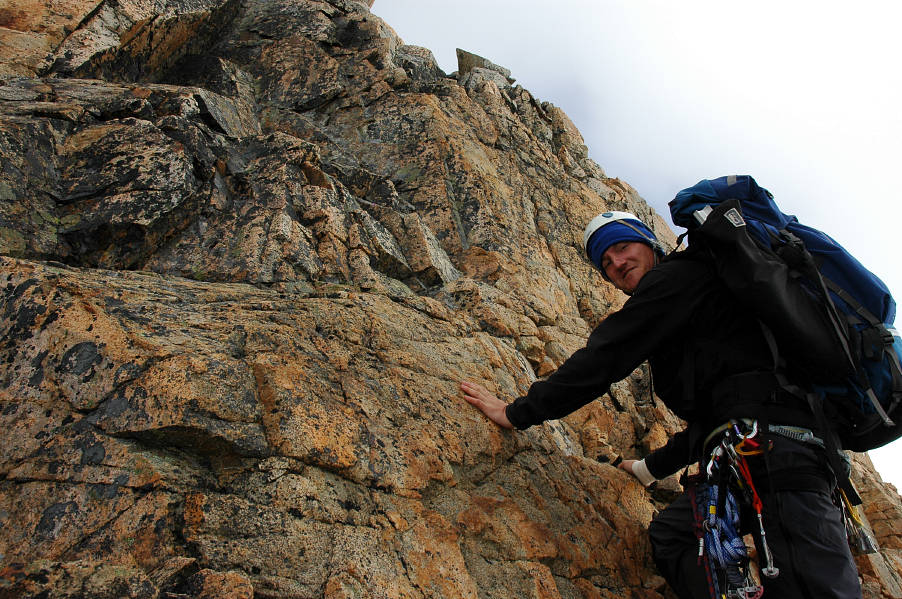
Mike made his way up the rock, looking for places to put protection in, but found little and found himself thirty feet off the deck before he finally got a cam in. Mike moved around a corner and was out of site. We could hear rocks come screaming down the mountain. "That's just me," Mike said. He was cleaning loose rocks off the route as he went, something you tried to avoid when there were other climbers about. But we were the only ones for, probably three hundred miles. Assuming some one was climbing Devil's Thumb.

As Mike progressed, the weakness of our new rope set up became apparent. By the time he reached a suitable anchor, the 40 meter strand was 20 feet above us. Bob tied into the 60 meter strand and climbed to the 40 meter, where he switched over and continued on up. Five minutes later it was my turn. I broke down the anchor and cleaned the route on my way up, enjoying the fun climbing. Except for the run out parts, the climbing would have been a gas on lead, even in boots. From where Mike had built the anchor it was a short stroll up blocky rocks to the summit.

Unlike White Rabbit, we had actually topped out, actually been the first to summit this peak. Unlike White Rabbit, we have fine, pleasant weather and it was barely noon. We could lounge to our hearts' content as there was no rush to return to camp.
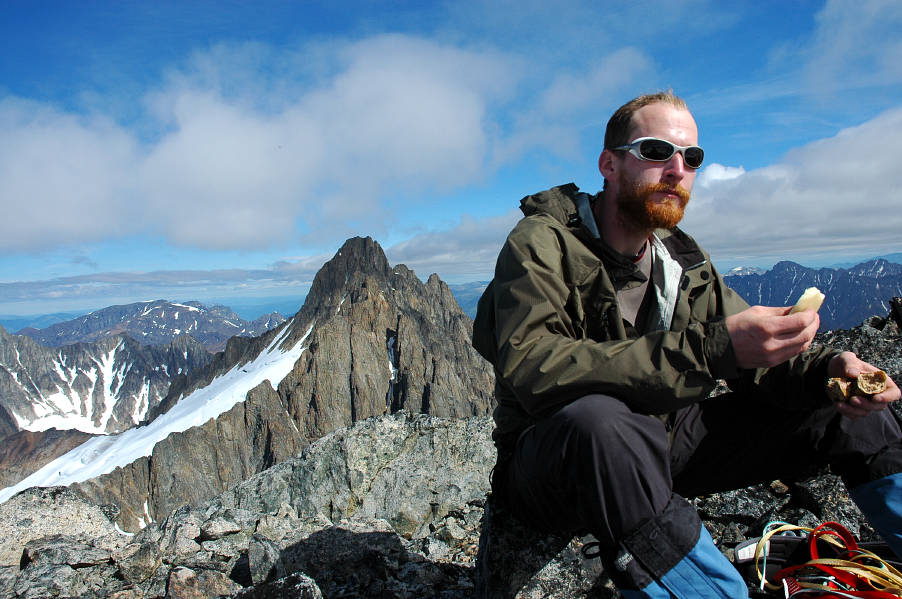
The thrill of getting a first ascent was more muted than I thought. We were standing on something that no one had ever reached before, we had done something that no one had ever done before. I had though that my ego would run rampant, would fly around inside my head and lift me off the ground. Instead, I lounged in the sun, relaxing and enjoying the views, satisfied, but not swelled. It was much like hiking up a long ridge overlooking an impossibly deep glacial valley and finding the perfect tree to sit under for a while and escape the sun.
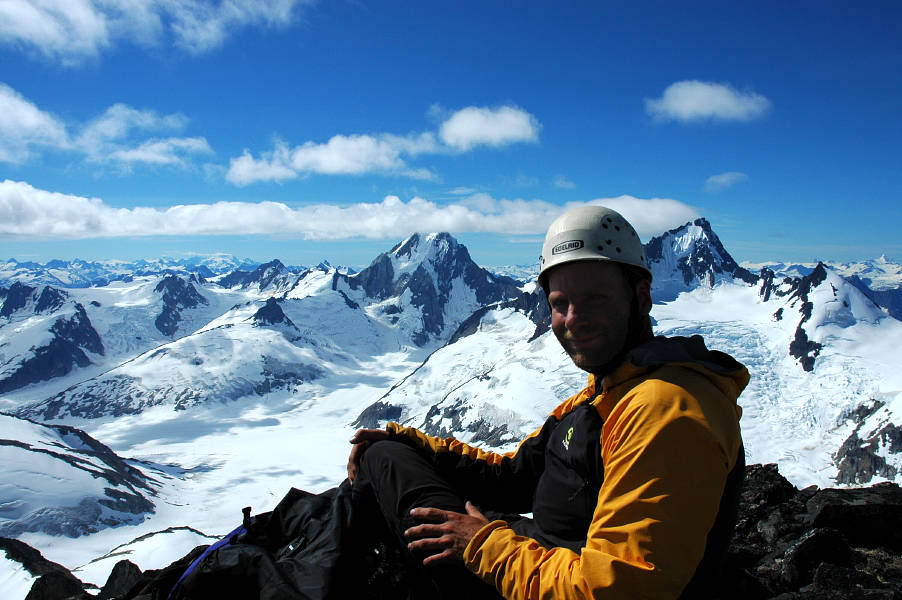
The views really were impressive, and we could see in a 360 degree panorama. There were only big puffy clouds in the sky and no haze. Deep to the south was the Scud glacier, our eventual retreat path. Long dark ribbons snaked down it, the signs of medial and lateral moraines running through the river of ice. It looked like a super highway. In the distance was the Mount Hickman area, where Mike, John, and Volker had battled and fought and clawed. They had come out in a valley that we could spot, and then motored, or rather straggled, for they were burnt on food, up the Scud and over the col and down to Yehiniko Lake. Mount Hickman had seen one known ascent, by the legendary Fred Beckey, and other less legendary figures, back in the late 60s. They choppered most of the way in and thus avoided the difficult approach that had stopped us.
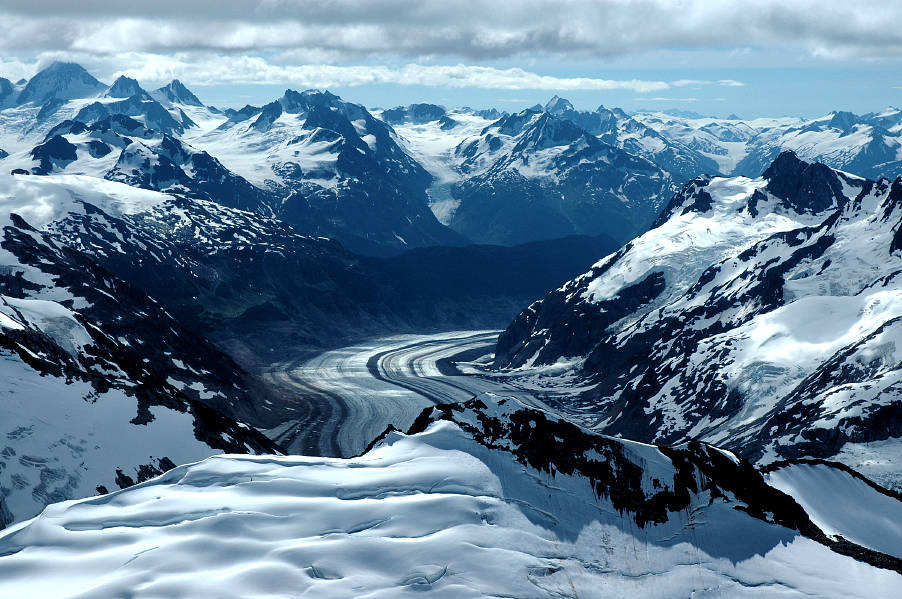
To the west lay Alaska and the Pacific Ocean, not very far as the crow flies. Of course, to reach there on foot would be a very serious undertaking, though not as difficult as one might suspect. In fact, one of our possible trips for this summer included just such a traverse, from Chutine Lake, a bit north and west of here, to the Pacific via massive ice fields. From left to right in the below picture you can our local terrain, with Endeavour, the Nipple, and Dokdaon appearing. In the far distance, in the center, is Mount Ratz.
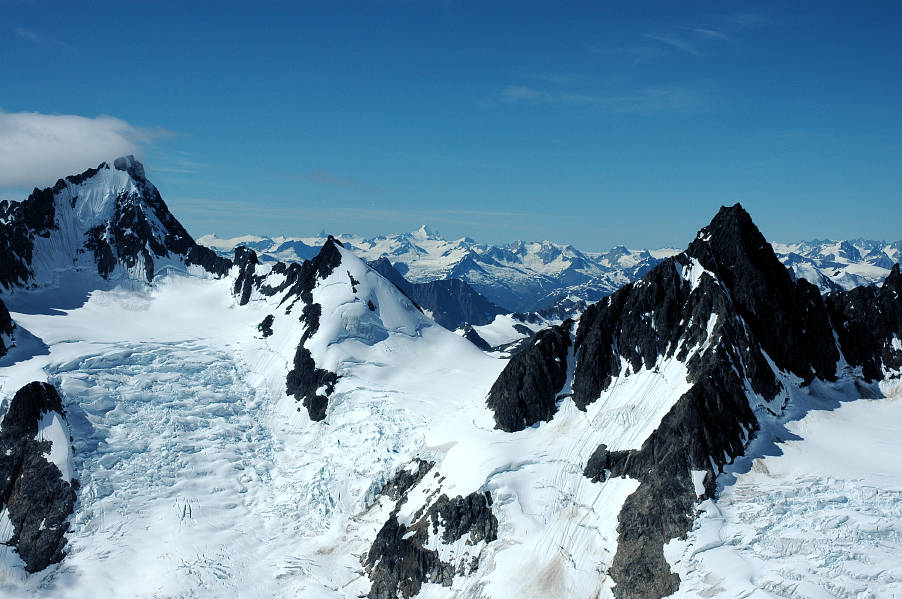
Mount Ratz is a giant, soaring more than 3000 meters above sea level. Sounds small, eh? After all, that would qualify it for something like fifth highest in Washington. It wouldn't even register in Colorado. But think again. Ratz sits on the BC-Alaska border and just to the west of it is the Pacific Ocean. So, from its 3000 meter summit, you're looking down 3000 meters to the ocean. The peak is surrounded by a massive ice field on every side and if you want to climb it, you have to be ready to suffer just to approach it. And how are you going to climb it? Ratz has been climbed only a handful of times and there is no guidebook for the area. Try calling up RMI or Alpine Ascents to hire a guide for a climb of Ratz. For bigger mountains like Whitney or Rainier, you can casually drive up and climb to the summit within a few hours (Whitney) or two days (Rainier), enjoying a pleasant stroll along the way. For Ratz, you'd be looking at weeks of bushwhacking and glacier travel. Have fun!
Note: The prominent rock spire to the far left is, we believe, The Devil's Thumb.

Mount Ratz would have to wait for some other time, some other day. Some time when I was harder, tougher, and had forgotten how pleasant sitting under a tree on a grassy knoll is. To the east sat White Rabbit, with the entire West Ridge exposed for us. Our route had thumped up to just below a very steep gendarme near the summit. From our final spot, we would have needed to down climb a bit and then some how rope up and protect one or two rock pitches to clear the final gendarme. We had definitely made the right decision to turn around, for we needed at least three more hours to ascend to the summit and probably would have burned the rest of our pitons and webbing.
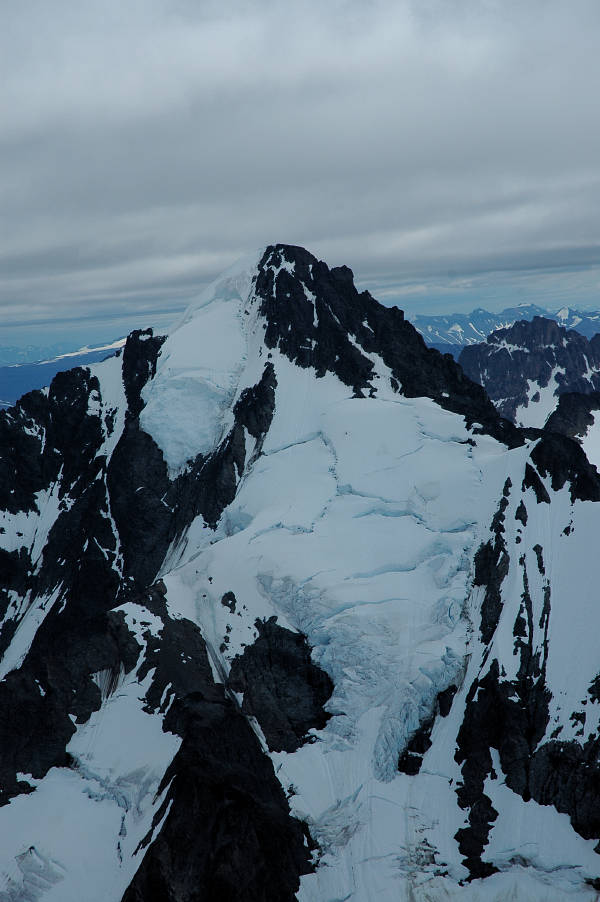
To the south west lay the land that Mike, John, and Volker struggled through. But it was also the area of some of their first ascents in 2004. Other than White Rabbit via the east face, they ascended the tooth shaped black peak in the foreground of the below photo, naming it Beaumont Peak after Doug Beaumont, our pilot. The ascent was via the glacier in the lower right half of the photo, involving mostly snow travel and little easy rock scrambling at the top.
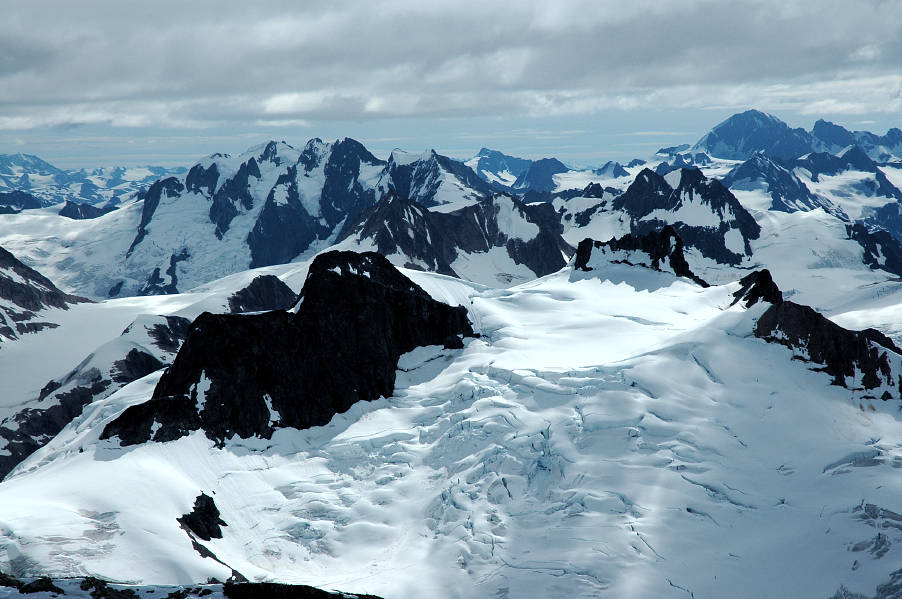
Further afield sat mighty Mount Hoole, one of the few named peaks of the area and, as far as is known, still unclimbed. Hoole was named for a Metis (half Native, half French) guide for Campbell, one of the early explorers that came into the area. Unless something strange happens on the other side, there does not seem to be any easy route to the top.
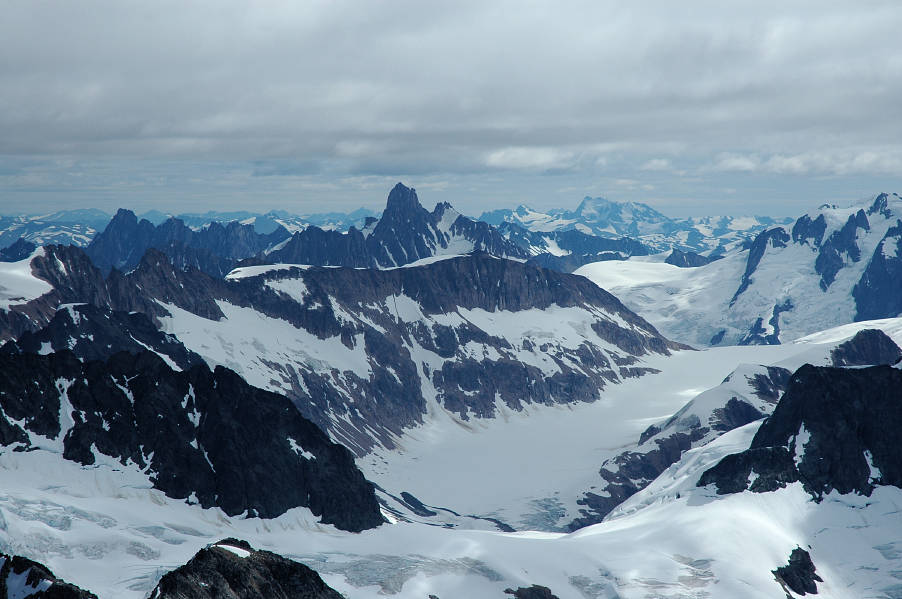
Due east lay the Edziza and Arctic plateaus. These highlands are nearly flat, broken only in the middle by the otherworldly Spectrum Range. In 2001 Mike, John, Kevin, and myself traversed through from Arctic Lake to Buckley Lake, a fun and enjoyable outing that requires few technical skills beyond route finding, talus and scree bashing, and basic snow and glacier travel. From north of the Spectrum Range to Buckley Lake there is a cairned route to follow as well. Cariboo and Stone Sheep abound. Directly behind Mike, not visible in the picture, is Mount Edziza, the remnant of a once high volcano that blew its top many years ago.

Looking north we could see the highest point of the Scud glacier, its end, flanked by an impressive peak that the Hardmen of '67 climbed. It has not seen a repeat ascent.
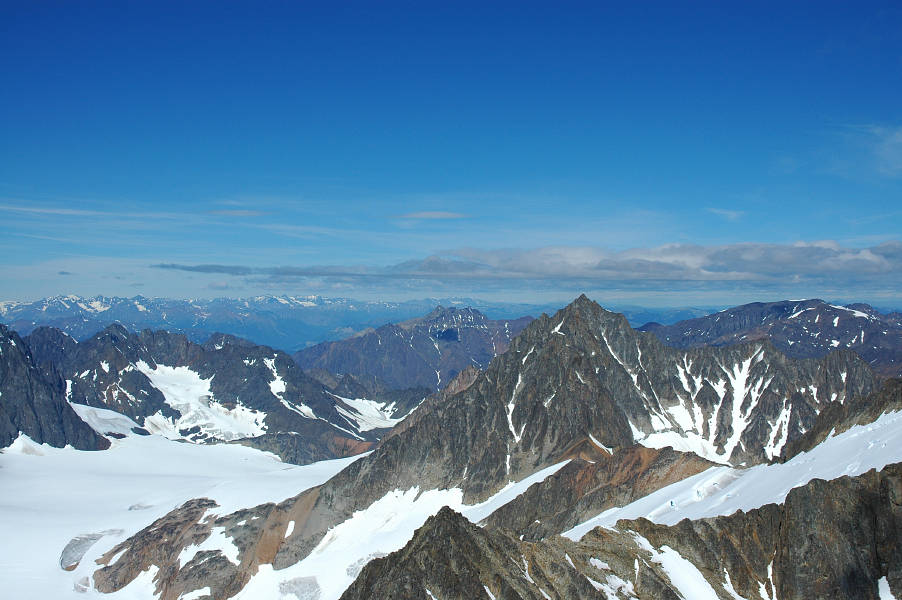
And across the Scud lay Dokdaon, looking very scary, but also very aesthetic. The Hardmen had climbed it, gaining the distinction of a first ascent, and it had not seen a repeat. We were planning on giving it a run, as it would yield excellent views down into the Stikine valley, nearly 2700 meters below it. We spent some time scoping it out for possible routes to the top and agreed with the Hardmen that climbing the steep, crevassed glacier below it (left side of photo) would be the best access. Hopefully the south ridge (left skyline) would provide better rock and easier going than the west ridge of White Rabbit.
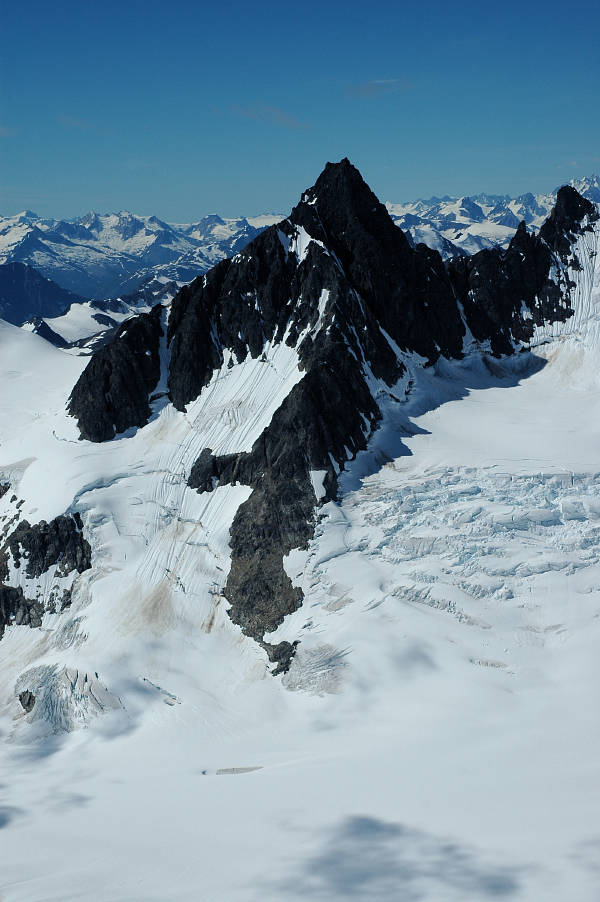
And lastly, yet another first ascent peak by the Hardmen of '67. They had given these peaks names, but I never quite got straight in my head which was Mount Doom and which Mordor. Sitting at the upper edge of the Scud, it might make for some fun times.
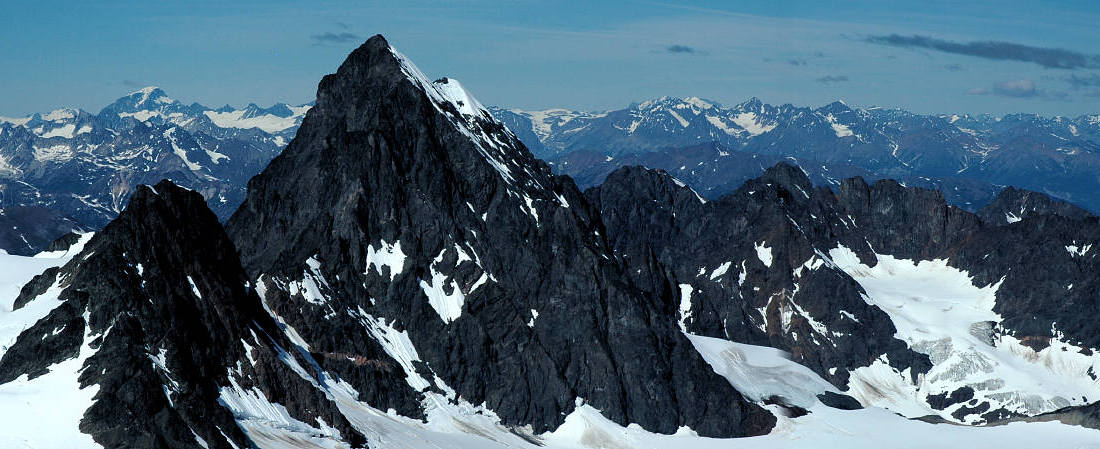
We had spent nearly an hour on the summit, debating what to call our new mountain. After some battling back and forth, we decided to call it The Doormouse, a bastardized spelling of a character's name from Alice in Wonderland, from which White Rabbit was also sourced. Besides being consistent with a previously named peak, the mountain sits, along with White Rabbit, on the door step of the Scud. We built a cairn that might survive for a while, at least until the winter came, took a GPS bearing, and began the retreat out.
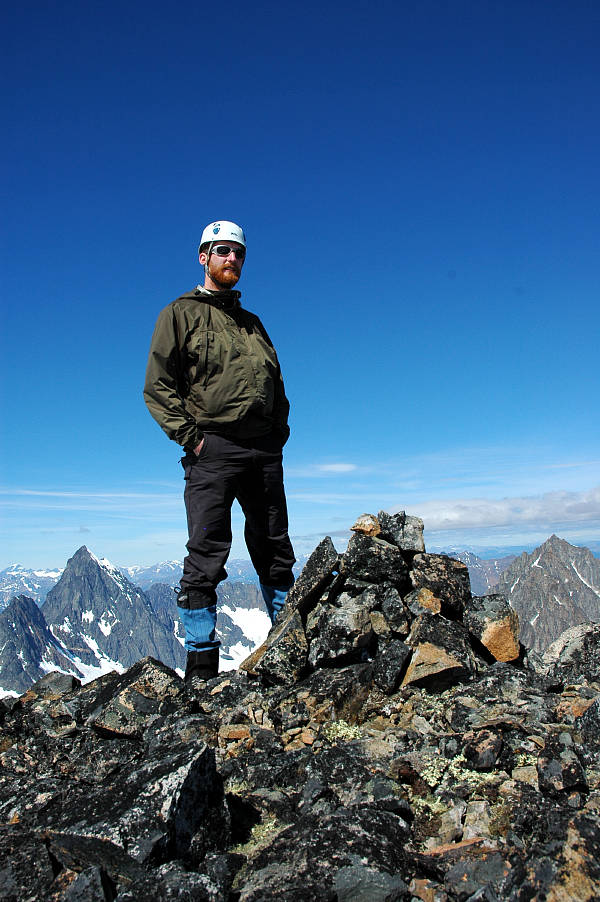
Now, getting off a mountain is more important than getting to the top of it. Unlike going up, though, we knew the route down, which helped mentally. My fear was in knocking rocks down on top of my friends, and there was plenty to knock down. The talus field wasn't very steep, which made the danger low, and the exposure was non-existent, which helped as well. But the views were just as grand. in the below photo, Mount Hickman is the peak with its summit in the clouds, in the upper left of the photo.

We reached our final anchor and searched around for a better place to rappel from. This is not as easy as it might sound, for we couldn't use the anchor we had already built: Once down, the rope would certainly get stuck when we tried to pull it. We searched for a while and eventually found a place were we could sling some large blocks and rappel down a more-or-less vertical face. This took nearly an hour, but we had a good anchor in a good position. Mike went first, clearing loose rocks as he went. I followed, rapping down just left of the climbing route. My terror at knocking down loose rocks meant a very slow pace, but I managed to reach the notch without kicking anything down. Bob was down shortly and we pulled the rope with (mostly) success. Mike had to solo up about fifteen feet to retrieve the end of it, stuck as it was around a small rock.

From the notch we now had some work to do. Our 20 meter rope was still dangling down from the other side of the notch, providing us with a top rope to work with. But the climb up looked hard. A slightly overhanging, off width crack was the only truly usable feature, with a blank face on the left. I swore I would prussik it instead of climbing it. I belayed Bob as he worked it, using the crack as he could.
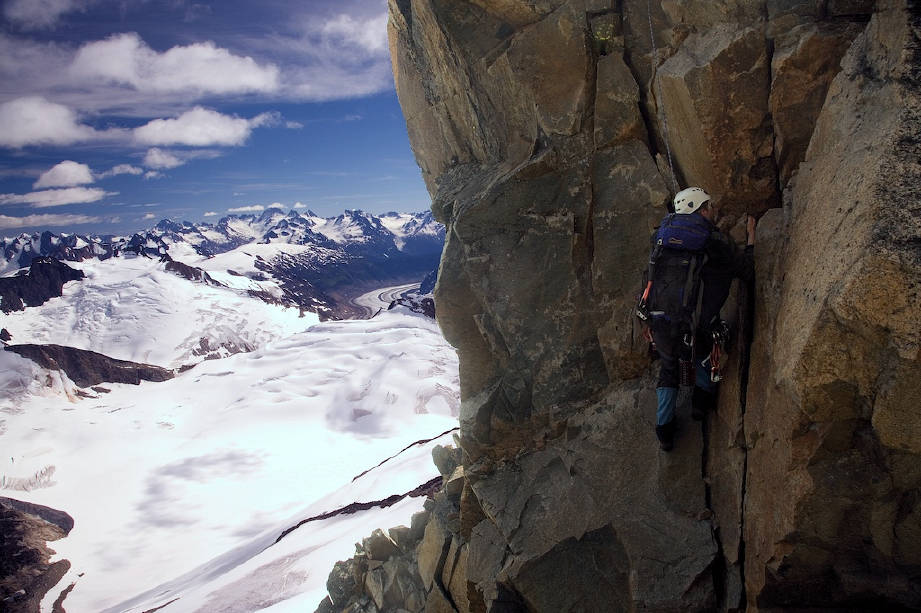
Bob is pretty solid on rock, especially in crack climbing. But off width cracks are not normal cracks. A bit of nomenclature. Finger cracks are cracks in the rock that are big enough for you to jam your fingers into. You are not holding the rock, but rather stuffing your fingers in and letting the rock hold you. Or so the theory goes. Hand cracks are the perfect size for your hands. A fist crack means that you need to make a fist and jam it in. Once you get beyond fist cracks, you have what is called an off width: Too big for a fist, too small to stuff your body into.
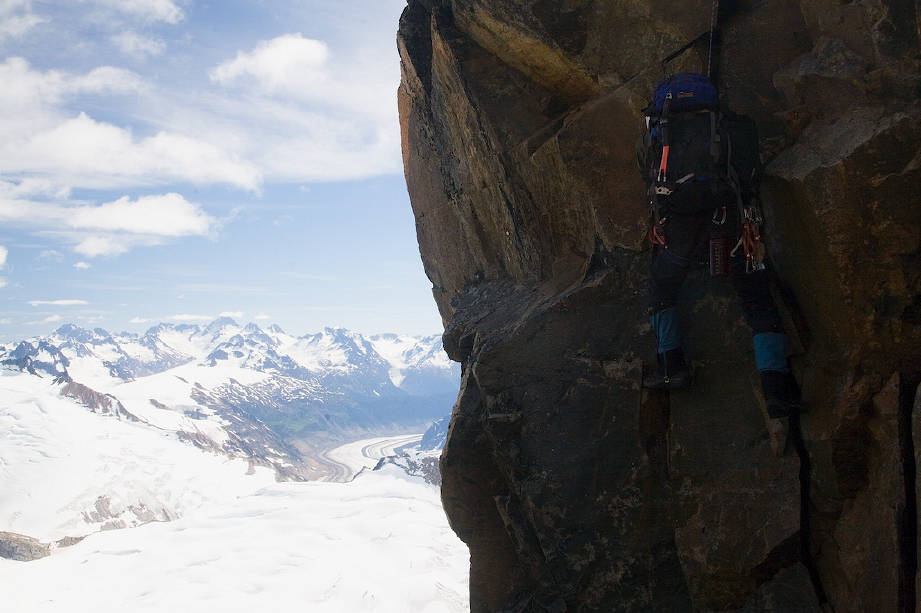
There are a few techniques, like stuffing your whole arm into the crack and making a "chicken wing". But mostly you grovel and sweat and curse and swear and do what ever you can to make it up. The fact that the crack was overhanging, especially at the top, meant that you couldn't balance your way up it: You had to jam something. Bob worked hard on the crack, finding the crux near the top where he had run out of feet. His progress was measured in inches, as he manhandled his way up, eventually topping out in a spray of sweat.

I belayed Mike up, who took a slightly different route to avoid using the crack lower down. His wrist was bothering him quite a bit and the overhanging crack at the top required him to use his right arm, the hurt one, quite significantly. After thinking about it for a while, he moved a little higher, then used the rope to hoist himself the rest of the way.
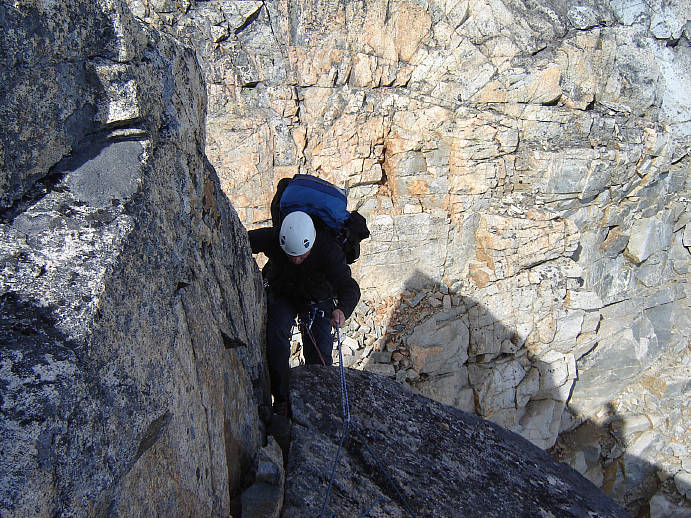
I kept insisting that I was going to prussik to the top, but when the time came I left the prussiks on my harness and gave the climb a shot. I ascended, as Mike did, a little while on the right face, gaining elevation through some sweet face climbing on smaller holds before moving back left into the crack and the overhang. I paused and thought for a while as Mike and Bob poured down encouraging words. I finally stepped across with my left foot onto a small nubbin and brought my body across, jamming the right foot solidly into the crack. Bob had chicken winged his way up, but I took to a more lay-back type climb. I groveled more, and swore more, and my progress was measured in quarter inches. Sweating and swearing my way up, I finally got high enough to mantle (i.e, flop over on my belly like some sort of GoreTex clothed whale) up on top. I was pretty tired and was happy to rest while Mike and Bob broke down the anchor.
We traversed back across the knife edge and down the easy talus field to where we had climbed up on the first roped pitch. We spent another 30 minutes finding and building a suitable anchor (another slung boulder) for a rappel down to the snow. Unfortunately, our ropes didn't quite reach the snow, a fact that I found out when I reached the end of the rope and still had a loose down climb to get to the snow, the solid, friendly, nice, welcoming snow. Snow is predictable. The rock we had been on wasn't. The others were down a ways from me, having scampered out of the fall zone before I rappelled down, and it took another 10 minutes before we had all gathered at the spot where we had left our snow gear earlier in the morning.
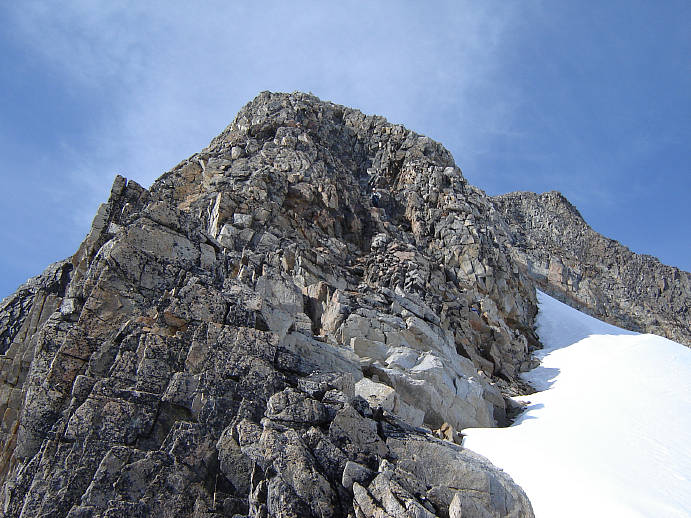
After resting and joking, and generally smiling, we roped for the glacier traverse and descent back to camp. We wanted to avoid the steeper sections of the glacier, and after a few mis-starts, managed to do just that, almost running down the lower inclined sections of snow. Once off the glacier, the rope came off and we proceeded back to camp at our own paces, free of the limitations and restrictions of the rope, reaching camp at the very civilized hour of 6:20 pm, a very relaxed day, though it was almost 12.5 hours in length.
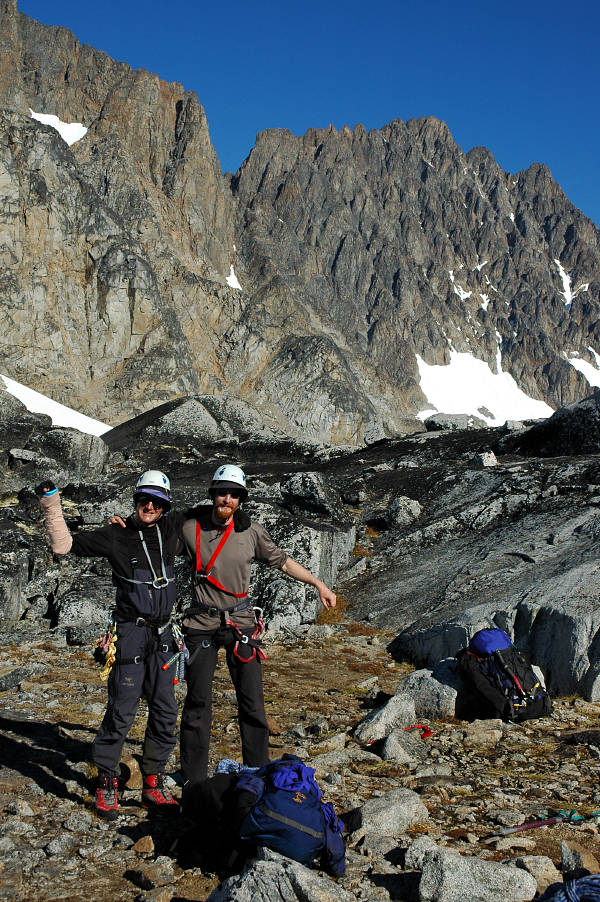
I boiled up a pot of soup for us to hydrate on, celebrating our first ascent with one of our few Knorr Extra Hot and Sour soups. From the camp, sipping on soup in safety, The Doormouse didn't look that large. It didn't seem that high. But I knew from experience that looks can be deceiving: Its summit was more than 3000 feet above us and the glacier was steeper than it looked. The little notch, that little notch that seemed so small and easy from down here, was in reality more than just a bother. It was part of the central technical difficulty of the climb. It was hard to tell from down here. In order to find out, in order to know it, we had to go and find out for ourselves. No guidebook had told us the way, we had no beta from anyone, no word of mouth, no hand drawn topo. Nothing. Nothing but ourselves. I was satisfied with the day.
